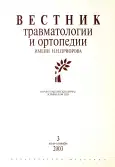Система пластин с угловой стабильностью (LCP) - новый АО стандарт накостного остеосинтеза
- Авторы: Neubauer T.1, Wagner М.1, Hammerbauer C.1
-
Учреждения:
- Отделение травматологии клиники Вильгельменшпиталь
- Выпуск: Том 10, № 3 (2003)
- Страницы: 27-35
- Раздел: Оригинальные исследования
- URL: https://journal-vniispk.ru/0869-8678/article/view/48138
- DOI: https://doi.org/10.17816/vto200310327-35
- ID: 48138
Цитировать
Полный текст
Аннотация
Система имплантатов с угловой стабильностью (LCP) является последней АО-разработкой в области накостного остеосинтеза пластинами, сочетающей в себе характеристики традиционных пластин и внутреннего фиксатора. Это достигается за счет комбинированного отверстия, одна половина которого (гладкая) предназначена для введения стандартных винтов, а другая половина, снабженная резьбой, — для введения блокирующихся винтов. Для фиксации через отверстия пластины LCP могут быть использованы любые виды традиционных винтов, а также блокирующиеся винты с резьбой (LHS). Поскольку механические характеристики пластины не изменились при добавлении комбинированных отверстий, имеется полный диапазон узких (3,5 мм) и широких (4,5/5,0 мм) АО пластин. Система LCP адаптирована к отдельным анатомическим зонам, например к проксимальному отделу плечевой кости, дистальному отделу лучевой кости; есть также специально разработанная система имплантатов для остеосинтеза при корригирующих остеотомиях большеберцовой кости Tomofix®. Начиная с четвертого квартала 2000 г. по декабрь 2002 г. авторами было имплантировано 310 LCP конструкций 274 пациентам. 303 (97,7%) пластины использованы для фиксации 285 переломов различной локализации у 267 пациентов, включая 17 (5,9%) переломов у детей,9 (3,2%) «околопротезных» переломов,5 (1,8%) случаев замедленной консолидации и 4 (1,4%) патологических перелома. 7 (2,3%о) пластин применены для фиксации фрагментов после остеотомии. Из общего числа пластин 111 (35,8%) фиксировали блокирующимися винтами,194 (62,6%) — обоими типами винтов и только 5 (1,6%)) пластин — традиционными винтами. 73 (23,5%) пластины имплантировали через минимально инвазивный доступ и 237 (76,5%) — из открытого доступа. Послеоперационные осложнения наблюдали у 14 (5,2 %) из 267 пациентов. Расшатывание имплантатов отмечено в 1,4 % случаев, глубокая инфекция — в 1,05%, остеомиелит, рефрактуры и послеоперационные гематомы — по 0,7%. Вторичное неправильное сращение и проблемы при удалении фиксатора имели место у одного (0,35%) пациента. Случаев замедленной консолидации или несращения не наблюдалось.
Ключевые слова
Полный текст
Открыть статью на сайте журналаОб авторах
Th. Neubauer
Отделение травматологии клиники Вильгельменшпиталь
Email: info@eco-vector.com
Австрия, Вена
М. Wagner
Отделение травматологии клиники Вильгельменшпиталь
Email: info@eco-vector.com
Австрия, Вена
Ch. Hammerbauer
Отделение травматологии клиники Вильгельменшпиталь
Автор, ответственный за переписку.
Email: info@eco-vector.com
Австрия, Вена
Список литературы
- Babst R., Hehli М., Regazzoni Р. //Unfallchirurg. — 2001. — Bd 104. — S. 530-535.
- Baumgaertel F., Gotzen L. //Ibid. — 1994. — Bd 97. — S. 78-84.
- Baumgaertel F., Buhl M., Rahn B.A. //Injury. — 1998. — Vol. 29, Suppl. 3. — P. 3-6.
- Brunner C.F., Weber B.G. Special techniques in osteosynthesis. — Berlin—Heidelberg; New York,1981.
- Danis R. Theorie et practique de l’osteosynthese. — Paris,1949.
- Farouk О., Krettek C., Miclau T. et al. //Arch. Orthop. Traum. Surg. — 1998. — Vol. 117. — P. 438-441.
- Frigg R., Appenzeller A., Chistensen R. et al. //Injury. — 2001. — Vol. 32, Suppl. 3. — P. 24-31.
- Frigg R. //Ibid. — 2001. — Vol. 32, Suppl. 2. — P. 63-66.
- Gaultier E., Ganz R. //Zbl. Chir. — 1994. — Bd 119. — S. 564—572.
- Haas N., Hauke Ch., Schutz M. et al. //Injury. — 2001. — Vol. 32, Suppl. 2. — P. 51-62.
- Heitemeyer U., Hierholzer G., Terhorst J. //Unfallchirurg.— 1986. — Bd 89. — S. 533-539.
- Heitemeyer U., Claes L., Hierholzer G. //Ibid. — 1990. — Bd 93. — S. 49-55.
- Helfet D.L., Shonnard P.Y., Levine D., Borrelli J. //Injury. — 1997. — Vol. 28, Suppl. 1. — P. 42-47.
- Johnson E.E. //Clin. Orthop. — 1988. — N 231. — P. 154-162.
- Kinast C., Bolnhofer B.R., Mast J.W., Ganz R. //Ibid. — 1989. — N 238. — P. 122-130.
- Krettek C., Gerich T., Miclau Th. //Injury. — 2001. — Vol. 32, Suppl. 1. — P. 4- 13.
- Marti A., Frankhauser C., Frenk A. et al. //J. Orthop. Trauma. — 2001. — Vol. 15. — P. 482-487.
- Mast J., Jakob R., Ganz R. Planing and reduction technique in fracture surgey. — Berlin—Heidelberg; New York,1989.
- Mc Ferran M.A., Smith S.W., Boulas H.J., Schwartz H. //J. Orthop. Trauma. — 1992. — Vol. 6. — P. 195-200.
- Miclau Th., Martin R.E. //Injury. — 1997. — Vol. 28, Suppl. 1. — P. 3-6.
- Ostrum R.F., Geel C. //J. Orthop. Trauma. — 1995. — Vol. 9. — P. 278-284.
- Perren S.M., Cordey J., Rahn B.A. et al. //Clin. Orthop. - 1988. — N 232. — P. 139-151.
- Perren S.M., Klaue K, Pohler O. et al. //Arch. Orthop. Traum. Surg. — 1990. — Vol. 109. — P. 304-310.
- Perren S.M. //Injury. — 1995. — Vol. 26, Suppl. 1. — P. 1-10.
- Perren S.M. //Ibid. — 2001. — Vol. 32, Suppl. 2. — P. 1-10.
- Perren S.M. //J. Bone Jt Surg. — 2002. — Vol. 84B. — P. 1093-1110.
- Russell G.V., Smith D.G. //J. Trauma. — 1999. — Vol. 47. — P. 799-801.
- Schenk R., Willenegger H. //Experientia. — 1963. — Vol. 19. — P. 593-595.
- Schutz M., Muller M., Krettek C. et al. //Injury. — 2001. — Vol. 32, Suppl. 3. — P. 48-54.
- Sturmer K.M. //Unfallchirurg. — 1996. — Bd 99. — S. 816-829.
- Tepic S., Reminger A., Morikawa K. et al. //J. Orthop. Trauma. — 1997. — Vol. 11. — P. 14-23.
- Tscherne H., Trentz O. //Unfallheilkunde. — 1977. — Bd 80. — S. 221-230.
- Wagner M., Frigg R. //OP-J. — 2000. — Vol. 16. — P. 238-243.
- Wagner M. (edit.). Locking Compression Plate, AO Teaching Series, interactive CD-ROM. — 2002, AO International.
- Wagner M. //Injury. — 2003 (accepted).
- Young M.J., Barrack R.L. //Orthop. Rev. — 1994. — Vol. 23. — P. 149-154.
Дополнительные файлы















